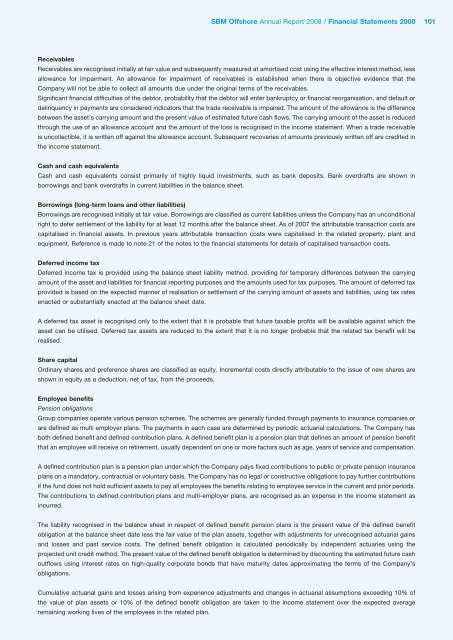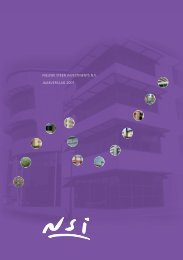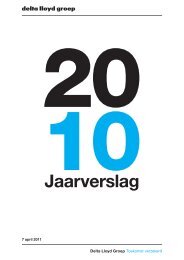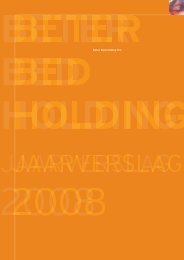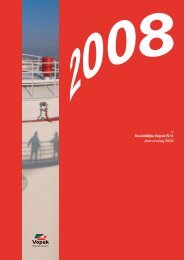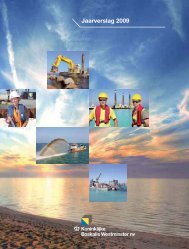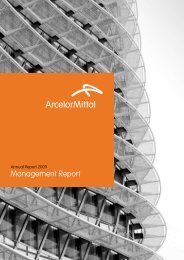2008 Annual Report - SBM Offshore
2008 Annual Report - SBM Offshore
2008 Annual Report - SBM Offshore
- No tags were found...
You also want an ePaper? Increase the reach of your titles
YUMPU automatically turns print PDFs into web optimized ePapers that Google loves.
<strong>SBM</strong> <strong>Offshore</strong> <strong>Annual</strong> <strong>Report</strong> <strong>2008</strong> / Financial Statements <strong>2008</strong> 101ReceivablesReceivables are recognised initially at fair value and subsequently measured at amortised cost using the effective interest method, lessallowance for impairment. An allowance for impairment of receivables is established when there is objective evidence that theCompany will not be able to collect all amounts due under the original terms of the receivables.Significant financial difficulties of the debtor, probability that the debtor will enter bankruptcy or financial reorganisation, and default ordelinquency in payments are considered indicators that the trade receivable is impaired. The amount of the allowance is the differencebetween the asset’s carrying amount and the present value of estimated future cash flows. The carrying amount of the asset is reducedthrough the use of an allowance account and the amount of the loss is recognised in the income statement. When a trade receivableis uncollectible, it is written off against the allowance account. Subsequent recoveries of amounts previously written off are credited inthe income statement.Cash and cash equivalentsCash and cash equivalents consist primarily of highly liquid investments, such as bank deposits. Bank overdrafts are shown inborrowings and bank overdrafts in current liabilities in the balance sheet.Borrowings (long-term loans and other liabilities)Borrowings are recognised initially at fair value. Borrowings are classified as current liabilities unless the Company has an unconditionalright to defer settlement of the liability for at least 12 months after the balance sheet. As of 2007 the attributable transaction costs arecapitalised in financial assets. In previous years attributable transaction costs were capitalised in the related property, plant andequipment. Reference is made to note 21 of the notes to the financial statements for details of capitalised transaction costs.Deferred income taxDeferred income tax is provided using the balance sheet liability method, providing for temporary differences between the carryingamount of the asset and liabilities for financial reporting purposes and the amounts used for tax purposes. The amount of deferred taxprovided is based on the expected manner of realisation or settlement of the carrying amount of assets and liabilities, using tax ratesenacted or substantially enacted at the balance sheet date.A deferred tax asset is recognised only to the extent that it is probable that future taxable profits will be available against which theasset can be utilised. Deferred tax assets are reduced to the extent that it is no longer probable that the related tax benefit will berealised.Share capitalOrdinary shares and preference shares are classified as equity. Incremental costs directly attributable to the issue of new shares areshown in equity as a deduction, net of tax, from the proceeds.Employee benefitsPension obligationsGroup companies operate various pension schemes. The schemes are generally funded through payments to insurance companies orare defined as multi employer plans. The payments in each case are determined by periodic actuarial calculations. The Company hasboth defined benefit and defined contribution plans. A defined benefit plan is a pension plan that defines an amount of pension benefitthat an employee will receive on retirement, usually dependent on one or more factors such as age, years of service and compensation.A defined contribution plan is a pension plan under which the Company pays fixed contributions to public or private pension insuranceplans on a mandatory, contractual or voluntary basis. The Company has no legal or constructive obligations to pay further contributionsif the fund does not hold sufficient assets to pay all employees the benefits relating to employee service in the current and prior periods.The contributions to defined contribution plans and multi-employer plans, are recognised as an expense in the income statement asincurred.The liability recognised in the balance sheet in respect of defined benefit pension plans is the present value of the defined benefitobligation at the balance sheet date less the fair value of the plan assets, together with adjustments for unrecognised actuarial gainsand losses and past service costs. The defined benefit obligation is calculated periodically by independent actuaries using theprojected unit credit method. The present value of the defined benefit obligation is determined by discounting the estimated future cashoutflows using interest rates on high-quality corporate bonds that have maturity dates approximating the terms of the Company’sobligations.Cumulative actuarial gains and losses arising from experience adjustments and changes in actuarial assumptions exceeding 10% ofthe value of plan assets or 10% of the defined benefit obligation are taken to the income statement over the expected averageremaining working lives of the employees in the related plan.


